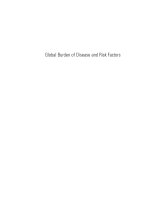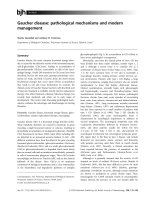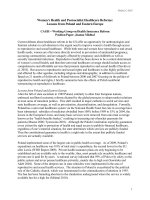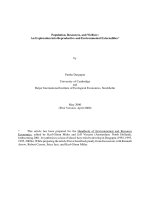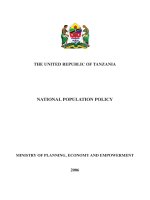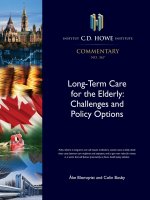Informed choice and immunisation programmes ppt
Bạn đang xem bản rút gọn của tài liệu. Xem và tải ngay bản đầy đủ của tài liệu tại đây (476.79 KB, 4 trang )
women’s health
update
Women’s Health Update features women’s
health news, policy and scientific findings,
to enable health care professionals and
community-based workers to be at the
forefront in women’s health.
Women’s Health Update is published
by the Women’s Health Action Trust
Women’s Health Update is produced by Women’s Health Action Trust
•
Edited by Jo Fitzpatrick
To receive copies of Women’s Health Update, make suggestions about future contents or send items
for publication please contact: Women’s Health Action Trust
•
PO Box 9947, Newmarket, Auckland, NZ
2nd Floor, 27 Gillies Avenue
•
Ph (09) 520 5295
•
Fax (09) 520 5731
•
email:
Internet address:
•
Women’s Health Update is published with the assistance of the Ministry of Health
Women's Health Action Trust celebrating 20 years 1989-2009
The school-based
phase of the HPV
(human papillomavirus)
immunisation programme
that will provide Gardasil
vaccine for girls from
12 years old is about to
start. Given the debate
on the failure of informed
consent processes with
the MeNZB immunisation
programme, and
a troubling start to
the national HPV
immunisation programme
launched in September
last year, it is timely to raise concerns about
the fate of informed choice and consent in the
school-based phase of the programme. Christy
Parker looks at some of the ethical issues
surrounding mass immunisation programmes
targeting children and young people and
argues that the principles of informed choice
and consent must not be compromised by
population health objectives.
During the last 50 years mass immunisation
programmes have been effective in protecting
people against infectious diseases alongside
other public health measures. However, while
successful, these programmes have remained
controversial often with fierce debate over both
the context and their implementation (Verweij
& Dawson, 2004). There are two major groups
of ethical issues which cause controversy. The
first relate to the development, introduction,
and availability of new vaccines. There is
much debate about the principles that should
be applied in deciding which programmes are
funded, about how these decisions are made,
and by whom (Verweij & Dawson, 2004). The
role of pharmaceutical companies who stand
to make millions, or even billions, in decisions
Inside
● Menopause,Midlifeand
Metabolism
● M¯aoriWomenand
Breastfeeding
● NewWomen’sHealth
ActionWebsite
● Resourcesandonline
supportgroupfor
women
continued on page 2
vol13 no1•February2009
Informed choice and
immunisation programmes
Informed choice and consent are not
niceties in New Zealand; they are enshrined
in law through the Code of Health and Disability
Services Consumers’ Rights. The Code of
Rights, which became law in 1996 confers a
number of rights on all consumers of health and
disability services in New Zealand, and arose
out of the Cartwright Inquiry with its damning
findings about the treatment of women with
cervical cancer at National Women’s Hospital, a
scandal termed the “Unfortunate Experiment”.
Rights six and seven of the code define health
and disability services consumers’ rights to full
information to enable them to make an informed
choice and give their informed consent for any
proposed health intervention. Right six is the
right to be fully informed. The consumer can
expect an explanation of the options available
including an assessment of the expected risks,
side effects, benefits, and costs of each option.
Right six also stipulates:
Before making a choice or giving consent,
every consumer has the right to the information
that a reasonable consumer, in that consumer’s
circumstances, needs to make an informed
choice or give informed consent.
Right seven outlines the right to make an
informed choice and give informed consent.
about national vaccination programmes is
particularly contentious. Broader debates about
the safety and efficacy of vaccines also continue
to be very active.
The second major group of ethical issues,
and the ones which are the focus of this article,
concern the implementation of vaccination
programmes: the means used to achieve high
vaccination uptake, and the information and
communication processes involved (Verweij
& Dawson, 2004). When extraordinarily high
immunisation targets, aggressive marketing
campaigns, and one sided information
resources are employed, they risk undermining
consumers’ rights to informed choice and
informed consent (See Box). There is an
inherent tension between these rights, and
the objectives of population health which
seek the highest uptake of interventions (such
as screening or immunisations) to reduce
the incidence of a disease across the whole
population. The tension is further complicated
when an intervention is aimed at children and
young people and the right to informed choice
and informed consent includes their parents.
continued from page 1
International research has explored this
tension and the ways that the communication
and implementation of childhood immunisation
programmes, aimed at maximising uptake, can
undermine consumers’ (or their parents) rights to
make an informed choice. Offering practitioners
financial incentives to meet high uptake
targets works to undermine informed consent
processes, especially when practitioners also
believe that it is their “moral responsibility” to
ensure children are immunised. Alderson et al
(1997) asked primary health care practitioners
in the United Kingdom about their views on
childhood immunisation and how targets with
financial incentives might affect parent’s choice.
They found that ‘official’ targets and guidelines,
as well as one-sided information resources, had
a significant impact on how these practitioners
approached informed choice and informed
consent in vaccination programmes. Almost
all of the practitioners which included GPs,
practice nurses and health visitors felt obliged
to carry out government policy even if they felt
this was damaging to their patient relationships.
One GP stated:
I feel angry about targets. My relationship with
patients is becoming increasingly damaged. I
think, increasingly, things like coercive consent
will become a problem; they’ll see me more as
a policeman, not a doctor (Alderson et al, 1997:
96)
Many practitioners also described a special
moral duty to children which superseded the
rights of parents to make an informed choice.
It was apparent that policies encouraging high
uptake leant institutional support to these
attitudes. The comments of one GP were
particularly concerning:
My duty is to the child, and not to have the
child immunised because of grandmother’s
prejudice is unacceptable as far as I’m
concerned…If a child comes in and I notice the
child hasn’t had them, I sometimes will do them
opportunistically. I think targets have improved
rates. There’s no doubt that money talks, and
it’s meant a lot of GPs have got themselves
sorted out.
The reluctance to provide full information and
facilitate discussion about the risks and benefits
of immunisation for fear that parents would not
make the “right” choice was reported by many
practitioners, leading one practitioner to state
rather revealingly ‘consent is about compliance,
we need to do more work on how to get them
to comply, to take it up’. Parents who chose not
to have their children immunised tended to be
seen as irresponsible and/or irrational.
The recent MeNZB immunisation programme
was a worrying local example of the fate of
informed choice and consent when the goal
of childhood immunisation programmes is
to achieve the highest possible uptake and
fast. When the $220 million dollar campaign
finished in May last year, parents were shocked
to discover that few of the children immunised
during the campaign remained immune to
Meningococcal B. Uncertainties about how
long immunity would last were not adequately
communicated to parents in the rush to achieve
high uptake targets, and many parents thought
that their children would be immune for life. The
failure of informed choice and consent processes
is not just a violation of health consumer’s rights
as enshrined in law, it is dangerous. Parents,
believing their children are immunised against
Meningococcal B, are less likely to be alert to
signs of this deadly disease.
Claims that fear-mongering and bullying
tactics were used to intimidate parents into
having their children immunised were reported
throughout the MeNZB campaign, and many
parents reported a lack of reliable and unbiased
information to assist their decision making
process. The approach to informed choice and
consent during the school-based phase of the
programme was particularly concerning to many
parents. An October 2007 study published in
the New Zealand Medical Journal found that
parents had a ‘largely unfulfilled desire for
reliable, valid and balanced information about
the MeNZB vaccine’ (Watson et al, 2007).
Parents – whether they decided to immunise
or not – frequently described the Ministry of
Health media publicity as ‘scare mongering’,
‘controlling people through fear’, ‘fear driven’,
‘not balanced’, and ‘one sided’. Even parents
with a more positive view made comments such
as ‘presenting the Government’s received view’
and ‘needing in some way to twist it to force
people to immunise’. Those parents with school
aged children reported concerns about the
graphic nature of information given to children
at school, in most cases without parental
consent; the use of child-based incentives; and
the short time frame given to parents to sign
consent forms, all of which left parents feeling
like they were being pressured into giving their
consent (Watson et al, 2007).
The roll out of the HPV immunisation
programme since September 2008 has also
raised concerns that the approach to its
implementation undermines health consumers’
ability to make an informed choice about the
vaccine. The Gardasil vaccine, which targets four
types of the human papillomavirus associated
with cervical cancer, some vulval and vaginal
cancers, and genital warts, is being offered to
all women aged 9-26, and is controversial for a
number of reasons. These include the vaccines’
infancy and the suspicion that it was rushed to
the market ahead of competitors for commercial
gain with inadequate evidence of its efficacy
and safety. Once again there are unanswered
questions around how long the vaccine will
offer immunity. HPV vaccination programmes
are also solely targeting girls and women when
HPV infection is present in boys and men and
is associated with other cancers and genital
warts. HPV is thus a sexual health issue, not a
women’s health issue and young women should
not have to bear the burden for reducing the
incidence of HPV related diseases. Further we
risk sending young women the message that
they alone are responsible for sexual health.
Gardasil is also one of the most expensive
vaccines ever sold and the programme will
cost hundreds of millions of dollars- prompting
questions about the gains given that women still
need regular cervical smears with or without the
vaccine. The HPV immunisation programme is
being introduced in two phases, the first phase
introduced in September last year through GPs
and primary health care practices for women
born in 1990 and 1991, and the second school
based phase late in term one of this year for girls
aged 12 to 18.
Concerns about the implementation and
communication of the HPV immunisation
programme echo those of the MeNZB campaign
and centre around the marketing of the vaccine;
the one-sided nature of the information resources
available to young women and their parents; and
the involvement of the pharmaceutical company-
CSL Biotherapies- in delivering the programme.
The decision to market the HPV vaccine as
the “cervical cancer vaccine” is factually
incorrect and obstructs consumers’ ability to
understand the relationship between HPV,
cervical cancer and Gardasil. The information
resources are also woefully inadequate and
fail to communicate uncertainties about
how long the vaccine will confer protection,
and that 90% of HPV infections are cleared
by the body naturally within two years. The
ethics of aggressive marketing campaigns
selling vaccines as “cool” to young women are
questionable- peer pressure should not be used
as a strategy to encourage vaccine uptake.
The Auckland District Health Boards ‘One
ForTheGirls’ “information” website about the
HPV programme is an example of the emphasis
on marketing over clear and honest evidence-
based information to assist decision making.
CSL’s biotherapies “remind me” compliance
programme alerts young women by email or
text when their follow up vaccines are due. It
is unethical for pharmaceutical companies with
major financial interests in vaccine uptake to
have this role, and the resulting direct contact
with young health consumers.
Ethical issues aside, safety is a major issue
if aggressive one-sided marketing campaigns
and poor information resources reduce young
women’s ability to make a meaningful informed
choice about Gardasil. Young women must
understand that they will still need to have regular
cervical smears because Gardasil does not
offer “lifetime protection from cervical cancer”
(as parents believed with meningococcal B).
Gardasil does not protect against all cancer
causing types of HPV and it is unknown how
long immunity will last- experience tells us the
duration of immunity is likely to be shorter than
first thought. If young women do not understand
the limitations of Gardasil there is a major risk
2
•
Women’s Health Update
•
vol 13 no 1
•
February 2009
Menopause, Midlife and Metabolism
Women’s Health Update
•
vol 13 no 1
•
February 2009
•
3
The 12th Australasian Menopause Society
(AMS) conference held in Melbourne in October
last year explored the issues of midlife and the
many changes that women experience at this
time. Jo Fitzpatrick gives us a brief overview.
Women’s Health Action doesn’t attend AMS
conference every year but this one promised a
wider look at common and uncommon midlife
problems not often discussed. It focused
on the impact and emergence of diseases
such as diabetes, depression, heart disease,
osteoporosis, metabolic disorder, and lupus
at the time of menopause; and included a full
session on vulval disorders.
Interesting points from the sessions on obesity
and metabolic syndrome include:
Most weight gain occurs pre and peri-
menopausally rather than at the time of
menopause and is particularly marked around
the midriff where it is also most dangerous in
terms of future health implications.
Low calorie diets, and particularly
Mediterranean diets, are useful for weight
control at this time and they are most useful
when combined with exercise.
Exercise needs to be varied and include
weight bearing and aerobic exercise and, to be
effective, should last for at least an hour a day.
Lifestyle changes, including fitness, change
of food habits and behaviours, remain the
bedrock of all medical strategies to manage
obesity. These changes include self-monitoring
with the doctor and the woman negotiating
agreed changes.
Drugs for other conditions may increase
weight and there are few effective drugs for the
management of obesity available.
Surgery - lap banding – results in major
positive changes but needs to be permanent
as small changes ‘easing-off’ the lap band have
resulted in rapid and dramatic weight gain.
Lifestyle related metabolic diseases are now a
primary cause of chronic disease in Australian
women and they are underpinned by a lack of
physical activity and excess food intake. They
include obesity; polycystic ovarian syndrome;
diabetes (including gestational and pre-
diabetes); and cardiovascular disease.
The vulval disorders section was extremely
useful in throwing light on these troubling and
troublesome midlife problems. It also confirmed
that this is a complex area which is not well
understood and may be difficult to treat. An in-
depth look at hot flushes identified 620 drugs
and 337 known drug interactions which were
known to cause ‘hot flushes’ and outlined
ways of determining whether hot flushes were
menopausal or indicative of other more serious
conditions. Many of the papers were useful and
fascinating which made this conference worth
attending.
This conference as always, was heavily
sponsored by drug companies and they were
well in evidence – as sponsors and advertisers
in the conference materials; as session sponsors
and as principal providers of food – served
surrounded by their stands on a mezzanine
floor.
References:
/>diet
/>mediterranean-diet/CL00011
A recently launched report brings to
completion qualitative research on factors
that influence breastfeeding for M ¯aori women:
the decision to breastfeed; the choice and
quality of breastfeeding advice; and the factors
influencing breastfeeding – both positively and
negatively. Sixty women and their whanau were
interviewed and the results shine a useful light
on M ¯aori breastfeeding today. The depth of
analysis has enabled the researchers to make
useful recommendations.
Particularly useful is a new model for
understanding how M ¯aori women are diverted
from breastfeeding. Five influencers were
indentified : breakdown in the breastfeeding
norm within the whanau, early interruptions to or
difficulties establishing breastfeeding, negative or
insufficient maternity support for breastfeeding,
lack of knowledge about how breastfeeding
changes over time and returning to work.
The recommendation in this report, for the
promotion of breastfeeding to M¯aori, would be
wisely taken heed of. “… focus on re-establishing
breastfeeding as a tikanga (right cultural practice)
rather than a perceived lifestyle choice.”
The published report of Marewa Glover,
Haarangi Manaena-Biddle, John Waldon and
Chris Cunningham was launched on Tuesday the
3rd of February at the University of Auckland.
For a copy of the full report send an $18 cheque
made out to: ‘Auckland Uniservices Ltd’ to
Marewa Glover, Social & Community Health,
The University of Auckland, Private Bag 92019,
Auckland Mail Centre 1142.
Shining a light: te whaangai uu – te reo o te aratika
M¯aori Women and Breastfeeding
that they may not participate in New Zealand’s
excellent cervical screening programme. Given
the uncertainties about the duration of immunity,
there is a real risk that by the time many of the
very young women who have the vaccine are
sexually active they may no longer be protected
from any of the strains of HPV. In the worst case
scenario, if these young women do not have
regular smears believing that they are protected
from cervical cancer we could actually see an
increase in the incidence of cervical cancer.
Good information when it comes to health
choices is a serious business.
As we prepare to launch the HPV programme
in our schools, it is timely that we look seriously
at the level of education and the information
resources we provide to the huge numbers
of young women we plan to vaccinate in the
course of these prgrammes. Consumers must
have easy access to full information and the
opportunity to make an informed choice
about vaccines, especially when a vaccine is
controversial. Consumers’ rights to do so are
fundamental to health service delivery in this
country. Verweij and Dawson (2004) argue that
analysis and discussion of the ethical issues
should be part of any justification of mass
immunisation programmes, perhaps especially
for those targeting children and young people.
Alderson et al (1997) urge policy makers to
take parents’ concerns and questions about
vaccination seriously and to include them in
these discussions, acknowledging them as the
experts in caring for their children. We must
remember that parents are the first to see the
impact of vaccines on their children’s health.
Alderson et al (1997) also urge the development
of detailed information booklets with clear
summaries of research reviews, statistics and
suggested questions to discuss rather than
relying on marketing resources that appeal
to parent’s guilt and fear, or to the culture of
“cool”.
Finally, serious questions need to be
asked about how we measure ‘success’ in
immunisation programmes. It’s too easy and
extremely dangerous to set high targets for
uptake and to see this as ‘success’ or ‘good
practice’ by health professionals. Best practice
should be measured by the number of people
who have been given enough information, time
to discuss this information, and who make a
meaningful informed choice, whether this be
to accept or decline the intervention. Despite
laudable objectives, we shouldn’t be bullied into
accepting anything less.
The full article, including references, can
be accessed from our website www.womens-
health.org.nz
women’s health
update
Women’s Health Update features women’s
health news, policy and scientific findings,
to enable health care professionals and
community-based workers to be at the
forefront in women’s health.
Women’s Health Update is published
by the Women’s Health Action Trust
Women’s Health Update is produced by Women’s Health Action Trust
•
Edited by Jo Fitzpatrick
To receive copies of Women’s Health Update, make suggestions about future contents or send items
for publication please contact: Women’s Health Action Trust
•
PO Box 9947, Newmarket, Auckland, NZ
2nd Floor, 27 Gillies Avenue
•
Ph (09) 520 5295
•
Fax (09) 520 5731
•
email:
Internet address:
•
Women’s Health Update is published with the assistance of the Ministry of Health
Women's Health Action Trust celebrating 20 years 1989-2009
Noticeboard
●
Well Child Week “listening
and talking”
2nd - 8th March
For further information please go to www.wellchild.org.nz
●
2nd hdC MediCo-legal ConferenCe
Wednesday 4 March 2009
Wellington
For more information please contact Julia Phillips on 04
494 7900
●
UnifeM, international
WoMen’s day Breakfast
8th March
For more information please contact: Liz Brown, Breakfast
Co-coordinator
Ph: 04 977 8783 or E-mail:
●
ViCtiM sUpport Week
11th - 18th March
For events please see www.victimsupport.org.nz
●
pUBliC leCtUres
“Who Cares? Narratives of People Who are Dying and
Their Families”
16th March
For more information on these lectures please go to http://
www.compassioninhealthcare.org
●
neW Zealand laCtation
ConsUltants assoCiation
Walking toUr 2009
Auckland - Monday 23 March
The Conference Centre, AUT Tech Park
Wellington - Wednesday 25 March
Terrace Conference Centre
Christchurch - Friday 27 March
Russley Golf Course
For more information please go to: kz4u.
co.nz/LinkClick.aspx?fileticket=72RH6F2lIGI%3d&tabi
d=3925
●
15th international CritiCal and
feMinist perspeCtiVes in health
& soCial jUstiCe ConferenCe
16 – 19 April 2009 Auckland
Conference themes are:
Health care system and practice interplay, Social justice
and challenges for society
Cultural challenges within health care, Power and practice
challenges,
Indigenous peoples and health care
For more information or to register go to contact Debbie
Payne at
●
Working With Child sexUal aBUse
Strengthening and Informing Practice
14th and 15th of May
For more information please see />Downloads/SymposiumDetails2009.pdf
Our newly developed Women’s Health Action
website was launched at our Women’s Suffrage
Breakfast on the 19th September. The new
website contains over 300 pages of up-to-date
information and research on women’s health
issues, policy, service developments and events.
It has been built on a database structured
template which will allow our staff members
to add pages to the site ensuring a site that is
regularly updated. It is an excellent resource
for health consumers; health care providers;
women’s and community health organisations;
and health policy makers and researchers alike.
Our submissions, newsletters and papers on
a wide range of women’s and consumer health
issues can be down-loaded directly from the site
as they become available. We welcome comment
and feedback on these. Also available on the
site are a range of gender-based analysis tools
for policy development; Women’s Health Action
press releases; quick reference hot topics;
upcoming events related to women’s health
and breastfeeding; and links to other women’s
organisations in New Zealand and around the
world.
Along with hundreds of pages of current
women’s health research and information, the
site includes a facility for making queries from
the site. WHA has a 24 hour Monday to Friday
turnaround policy on enquiries. Another useful
site feature is the down-loadable order form for
our women’s health resources and we hope to
have an electronic order form available in the
near future.
We welcome any feedback or comments
on the new site and how it can be improved
further.
The website address is www.womens-health.
org.nz.
New Women’s Health Action Website Launched
Women who are battling with mental health
or drug and alcohol problems as a result of
domestic violence now have a safe place to
go for on-line support. There are a number of
‘domestic violence’ websites about but this is the
first specifically for people who feel that domestic
violence has driven them mad.
www.hedrovememad.com is for people to
share experiences, discuss issues of concern,
ask and answer questions, provide information
on what helps and what doesn’t, advertise local
and national events and share information. The
website provides contact with people who not
only understand, but who have been in similar
situations and will provide support usually found
in face-to-face and group situations.
The site is secure; pseudonyms are used and
there is clear information on how to use the site
so that abusers are unable to trace and track
usage.
For health professionals and support services
working with these people, a CD and teaching
package is also available.
Flyers on the website for distribution and
display are available from debbie.neil@paradise.
net.nz.
Debbie also has more information on the DVD
and teaching package.
Resources and online support group for women

